This brief outline of the history of the town of Leicester, Massachusetts, was, for the greater part, compiled from essays written by pupils of the graduating class of the Leicester Center Grammar School, nineteen hundred and eleven, in response to the offer of a prize for the best composition on the subject from the Col. Henshaw Chapter, Daughters of the American Revolution. The matter has been arranged by a member of the chapter, assisted by the late Parkman T. Denny, and others.
January 27, 1686, a tract of land eight miles square was bought of the Nipmuc tribe of Massachusetts Indians, by nine men living, most of them, in Roxbury. Fifteen pounds, of the value of the money then used in New England, was paid for it, and the deed was signed by the heirs of the recently deceased chief, Oraskaso.
The place was known as Towtaid, and the towns we know as Leicester, Spencer, some of Paxton and twenty-five hundred acres of Auburn formed the purchase, which, geographically, is 42 degrees, 14 minutes 49 seconds north latitude, 71 degrees, 54 minutes 47 seconds west longitude. Our immediate vicinity was known to the settlers at first as Strawberry Hill. It is about fifty miles from Boston, six from its nearest neighbor on the east, Worcester, and something like one thousand and seven feet above sea level.
February 15, 1713-14, Leicester was made a town by the General Court of Massachusetts, and named after the old city of Leicester in England.
It was divided, February 23, 1713-14, the eastern part to be sold to settlers, the western to belong to the proprietors who now numbered twenty-two wealthy investors. In June of this year, John Chandler surveyed the town to determine the boundary lines which were said to have been established by the General Court.
The first Settler of the western half was Nathaniel Wood. These eighty lots, including the two for church and school, sold slowly, but in 1753 were incorporated as the town of Spencer, named after the lieutenant-governor of the colony, Spencer Phipps.
Lots in the eastern half were deeded on January 11, 1724, to thirty-seven different persons, among whom were ancestors of the Denny, Earle, Southgate, Henshaw, Smith and Sargent families, all since that time closely identified with the history of the town. Before this, by a vote of the proprietors, nominal allotments had been made of the fifty house lots into which this eastern part had been divided, at “a shilling an acre.”
In 1765 a strip of land two miles wide was taken from the northern side of the town for Paxton. About twenty-five hundred acres from the southeast part went to the town of Ward — now called Auburn — in 1778. The town now contains about thirteen thousand four hundred fifty-three acres.
The first settlement on Strawberry Hill was on lot numbered one, drawn by John Stebbins. May 14, 1714, Samuel Stebbins, the father of John and Joseph, was given a life interest in lots one and two, the sons being under age, as they might agree. Hereabouts was built, not later than, perhaps before, 1713-14, the first house. The site is identified by a granite marker.
Villages of Leicester Massachusetts
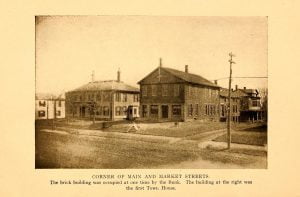
Two miles east of the Center village is Cherry Valley named in 1820. South Leicester, next called Clappville, from Joshua Clapp, who became the owner of the mill property there in 1829, and finally named Rochdale, in November, 1869, is about three miles south. This name was for Rochdale in England, the same kinds of cloth being manufactured here as there, and some of the people having come from that place.
Greenville, named for one of its first settlers, Captain Samuel Green, and once known as Hammertown, lies between Rochdale and the Center village.
Mannville, so called about 1856, after Mr. Billings Mann, who improved the water privilege of the neighborhood, is about two miles north of the Center.
About 1827, the northeast part of the town began to be known as Mulberry Grove, from the fact that Mr. Silas Earle attempted to start a silk industry there from the silk worms which fed upon the mulberry trees he had planted.
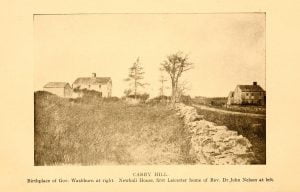
Legend tells us that a hermit was found by the exploring white men, living on what was afterwards from the name of its new settler, Arthur Carey, called Carey Hill. Another tradition says that Bald Hill in Cherry Valley was so called because it had already been cleared, and crops planted there before the white settlers came.
All about was a trackless forest, filled with wolves and rattlesnakes. There has been found no record of any Indian raids in this immediate vicinity, though the fear of such was great, and garrisons were built at the house of Rev. Mr. Parsons, on Strawberry Hill, at Judge Menzie’s near Henshaw Pond, at Jonah Earle’s in the northeastern part, and it is said, at the John King house, a couple of miles south of the center which was standing until about 1905.
The only natural ponds, those fed by springs, in town are Shaw Pond in the northwestern part, once called North Pond, and Henshaw Pond, only a mile southeast of the center, formerly known as Judge’s Pond, from being on the farm of Judge Menzies, an early comer, but known by its present name since the purchase of the property by Capt, David Henshaw. The house now standing, amid what must have once been imposing surroundings, was built about 1720.
There are many houses in the town which were built previous to 1800, and a large number were erected between that time and the completion of the May house in 1835.
Geology of Leicester Massachusetts

We are told by the historian of Leicester, the Honorable Emory Washburn, that “at the foot of Meeting House Hill, east of the principal village, the waters on the south side of the Great Road flow into the Quinnebaug,” thence into the Thames, “while those upon its north side find their way into the Blackstone,” and Narragansett Bay. Shaw Pond flows to the Connecticut, Burncoat to the Thames, and Waite Pond into the Blackstone.
Set into a retaining wall opposite Paxton Street is one of the original milestones, set up after the measuring of distances by Benjamin Franklin, indicating that it is “54 miles to Boston.”
Lake Sargent was originally the “Town Meadow,” and is still referred to as “Tophet” by old residents. Waite Pond, so called from adjoining the land of Nathan Waite, the innkeeper, was made from meadow land about 1847. This was until recently known as the Alice Waite Pond, Alice having been the daughter of Nathan Waite. A number of other ponds have been made by damming streams for mill privileges or reservoir use.
Leicester Center is supplied with water from Water springs in Paxton, with a stand pipe on Carey Supply Hill, built in 1891, by the Leicester Water Supply District. A new district was formed in 1910 to supply water to the villages of Cherry Valley, Rochdale and Greenville from wells at Henshaw Pond, with standpipes on Bald Hill and near Greenville. Worcester, our neighbor six miles to the east and five or six-hundred feet below us, obtains part of her water supply by damming Lynde Brook, in the northeastern part of the town. A series of three reservoirs extends along the road from Paxton to Lakeside. In the spring of 1876, this dam broke causing a flood which did great damage to the country below it, and to the mills and property in general in Cherry Valley.
An Indian trail passed through the old town of Leicester from east to west. This, in time, became the “Great Post Road,” extending from Boston to Albany. Leicester built her share of this in 1723. A vote by the town, taken in 1724, authorized the laying out of Pleasant street, or the “Charlton Road.” The next month the “Oxford Road,” Pine street, was voted for, and in 1739, Henshaw street, now so called, came into existence.
Early Leicester Massachusetts Industries
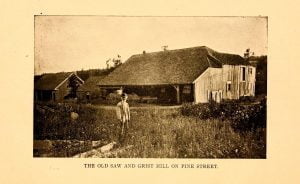
Leicester had a number of taverns in the old coaching days. As early as 1721, there was a public house at the northwest corner of Main and Paxton streets, then called respectively the “Great Post Road” and the “Rutland Road.” The original building was burned in 1767, but was rebuilt and occupied until somewhere about 1818. From 1727 until a few years previous to 1818, a tavern was kept on the Post Road opposite the present Catholic church. This building was taken down between 1855 and 1860.
Leicester Inn stands where a tavern has been carried on since 1776. Previous to, and during the Revolution, houses in the vicinity of Mt. Pleasant were used as taverns, and still others were to be found in Rochdale and Greenville, one on the road leading to Tatnuck, and one on the Paxton Road.
The first recorded town meeting was March 6, 1721-2, in the meeting house. Samuel Green was the moderator and was chosen first selectman, assessor and grand juror.
The first saw mill in Leicester was built by Captain Green, at Greenville.
Before 1730 a grist mill was built by William Earle on “Hasley Brook,” which flows into Lynde Brook in the northeast part of the town.
Carpenters came in 1717, and a very few years later a mason, a wheelwright, and a tailor had established themselves here. There were two hatters in the town at one time, and also a book bindery, a scythe manufactory, a small cotton mill, and a number of grist and saw mills.
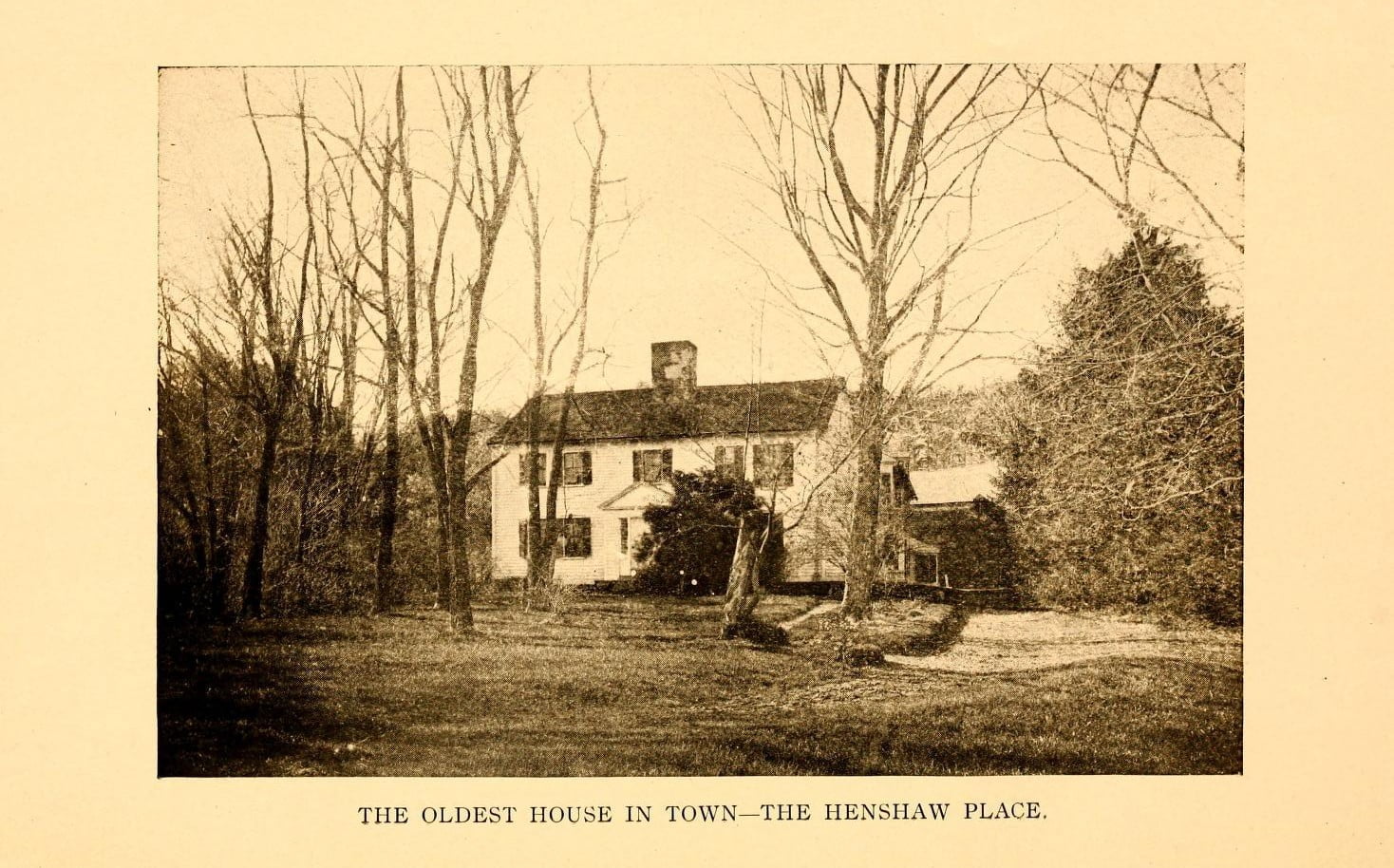
The manufacture of woolen goods was begun in 1814 by Mr. Samuel Watson, a clothier, in Cherry Valley. Mr. Thomas Bottomly has been called the founder of Cherry Valley, as, in 1821, he built the mill now known as the Olney mill, and thus formed the nucleus of the manufacturing village. In 1889 there were ten woolen mills in the town of Leicester.
The manufacture of satinets was begun in 1838 by Amos S. Earle and Billings Mann in the Mannville district. Earlier than this, satinets were woven by hand, in this same vicinity, for Mr. Samuel Watson, four yards being the extent of a day’s work, for which the pay was one dollar.
In the Kent planing mill and box factory, built at Lakeside in 1853, was set up the first circular saw in this part of the state.
After building a dam and canal, Chapel mill in Cherry Valley, was begun by John Waite, but, after being later used as a shuttle shop, it was in 1844, occupied as a wire mill by H. G. Henshaw. Two of his employees, Richard Sugden and Nathaniel Myrick, bought the machinery in 1849, with it established a large and profitable business in Spencer.
In 1830, five large tanneries and several small ones were in operation in the town.
Messrs. Horace and Warren Smith began to make shoes in 1866 at Mt. Pleasant. The same industry was carried on previously for a number of years by the Leicester Boot Co.
The machine knives made at the Hanky mill in Greenville for very many years, are exported to all parts of the world.

Leicester’s first settlers were farmers, and their clothing was made from thread spun by the women upon their own wheels, woven on their hand looms out of the flax or wool raised by them, as was the custom of the time.
Leicester has been made famous by the manufacture of card clothing, first by hand and then by machinery. The nature of the business did not admit of foreign labor, so Leicester had no foreign population during its early years. Nearly every name associated with the growth of Leicester Center is synonymous with the card clothing industry. It began with Edmond Snow who, in 1785, was making hand cards for wool. Mr. Pliny Earle, beginning the business the next year, was the first manufacturer of machine-made card clothing in the United States. This was in 1790. In 1837 there were seventeen concerns making hand cards in Leicester. In 1890, the American Card Clothing Co. took over the control of most of the card clothing factories in the United States, thus, because the works were moved to larger centers, depriving this village, Leicester Center, of its chief industry.
L. S. Watson & Company make hand cards, heddles, and so forth. They started the industry in 1842, later buying the business of J. B. and Edward Sargent. A member of the latter firm, George H. Sargent, founded the well known Sargent Hardware Commission House of New York.
The diversion of the water, which furnished the power for the mills at Lakeside and Mannville, to Worcester’s water supply, ruined the industries of those villages, and today but little remains of them.
Leicester Massachusetts Public Works and Buildings

The first town house was built in 1826. The same year the Leicester bank was chartered as a state institution with John Clapp its first president, and located in the town house. In 1853, the bank was removed to the second floor of a brick building standing at the east corner of the present Market street. In 1865 it was made a National bank and in 1871 was removed to the building now of the Leicester Savings Bank, which was incorporated in 1869. The National Bank was discontinued in 1904, when the Savings Bank purchased its building from the National Bank.
The present Town House was completed in 1855. It might be interesting to note that the bricks of which it was built were made on the farm of John E. Bacon in South Eastern Spencer.
At the town meeting in March, 1888, it was voted to contract with the Leicester Electric Co. to light the town hall by electricity. The following September steam heating was installed.
For some years before the Library building was finished, in 1896, the Town House contained the property of the Social Library, formed about 1793, and its successors of 1829 and the Public Library established in 1861. The two early collections of books were kept some time in a store near Pleasant Street, and some time in a private house. The Public Library is well equipped for its purposes. There is a juvenile department in the basement and a museum of considerable historical value on the second floor. On the first of January, 191 1, the library contained thirteen thousand eight hundred and fifty-seven volumes.
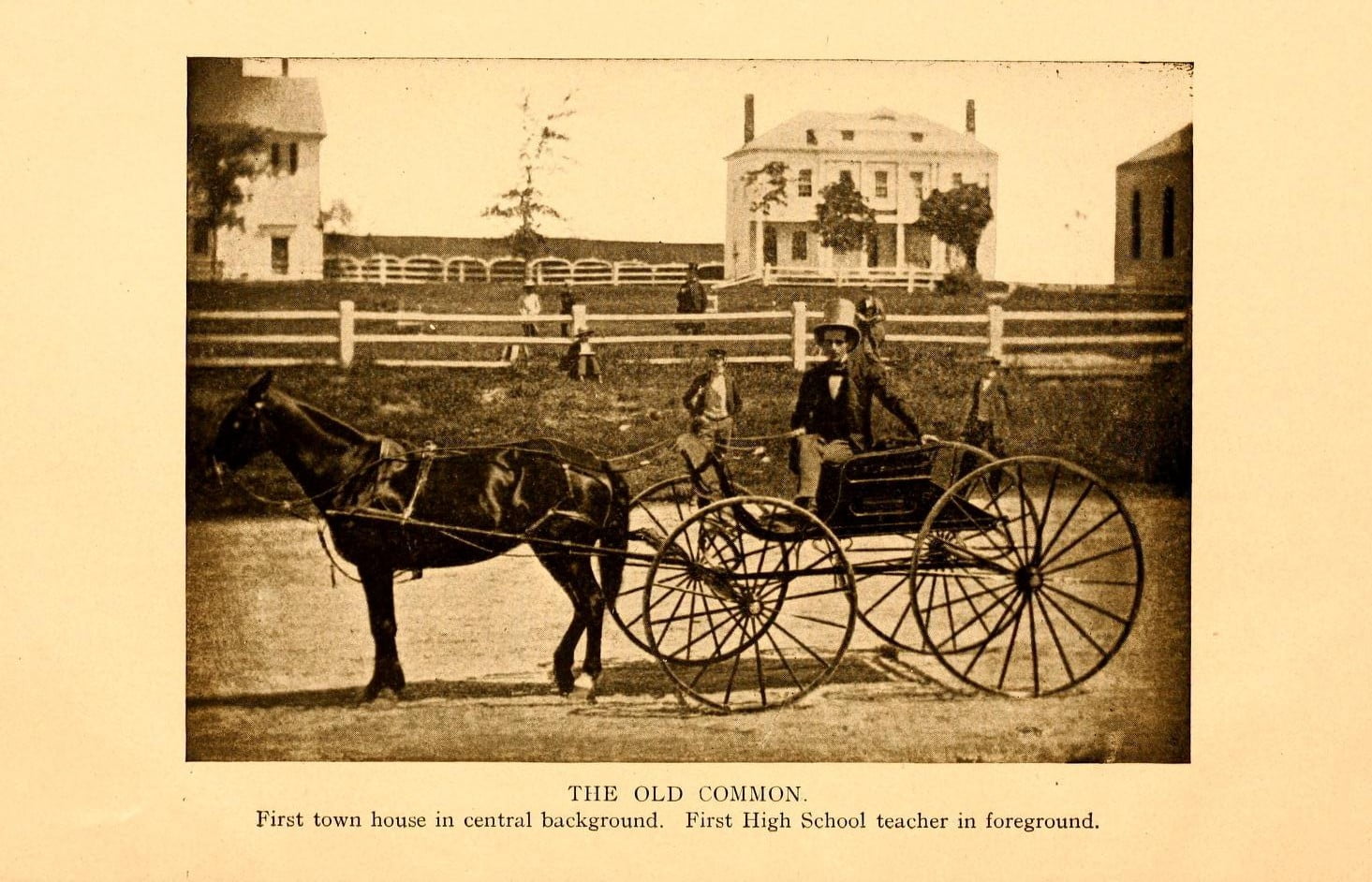
In 1801 an electric car line was established to succeed the old stage coach. This was the first suburban line out of Worcester.
In 1906 a telephone exchange was installed at the Center.
Electricity was first manufactured for illuminating purposes in this town by L. S. Wat Lights son and William F. Whittemore, the Leicester Electric Company, in the factory at “Lower Tophet.”
At the town meeting in March, 1889, it was voted to light the streets of the town with electricity. The evening of Aug. 13, 1889, eighty-two incandescent lamps of twenty-six candle power each illuminated the town.
Pipes were first laid for gas by the Worcester County Gas Company in 1905.
The first Post Office at the Center was probably established in 1798. Ebenezer Adams was the first commissioned postmaster. In 1826, Rev. Mr, Meunscher was made master of the Post Office then established at Clappville. In 1859, Harvey Tainter, Esq., was commissioned Postmaster at Cherry Valley. The mail was first brought to town by the “post rider” on the route from Worcester to Springfield. Later the stage coach brought it, and now it is conveyed from Worcester en the electric cars. Rural free delivery was established here in 1905.
As early as 1841 a fire department was projected. Somewhat later a steamer was purchased, partly by the town and partly by private subscription. Previous to this, for very many years, two “hand tubs” had been used. Apparatus and equipment has been purchased from time to time, that at the Center being housed in a small building in the rear of the Town House. Other pieces of apparatus are established in Rochdale and Cherry Valley.
History of the Churches of Leicester Massachusetts

As the religious affairs of early New England were conducted by the state, they form an almost inseparable part of its history. The first church had been built on the common, in Leicester, before the year 1719 arrived. It was erected by Captain Eleazer How, who, because he had been building the church, had not settled his own lot May 21, 1719, and was, in consequence, given until January 20 to do it. The meeting house was a very rude structure without embellishments or, indeed, conveniences of any kind. Later, each family built its own pew and furnished it with a foot-stove, if any heat was desired, and seats.
In November, 1720, the town voted “that Mr. David Parsons be our Gospel minster.” He was to have “the forty-acre lot next the meeting house, a salary of sixty pounds, and sixty pounds settlement.” As he hesitated to accept these terms, thirty of the settlers agreed to add to this amount so that the salary should be seventy-five pounds, and the settlement one hundred. He accepted this and became pastor in 1721. The town soon found itself short of funds and consequently could not pay the salary agreed upon. Within six years it was voted “that the town be willing that Mr. Parsons should remove and remain out of this town.” Thus began a quarrel that lasted for sixteen years. Mr. Parsons finally left March sixth, 1735, but died and was buried in Leicester. His grave is a few feet north of the house now occupied by Col. E. J. Russell on Paxton Street.
The third pastor, Rev. Joseph Roberts, was eccentric and a miser. After his death, at the age of ninety-six, bags of money were found hoarded in his garret, he having lived in extreme poverty,
A second meeting house was built, a little in the rear of the old site, in 1784. This was moved to the location of the present Congregational church in 1826, and sold in 1867, moved to the rear of the Academy and used for a gymnasium and some time for dormitories, until demolished in 1908.
The third church was a fine example of the best church architecture of that period. It was struck by lightning and burned in 1901. A stone church, dedicated the following year, now occupies nearly the same spot. The early New England faith, you will remember, was Orthodox.

The sixth pastor was the Rev. John Nelson, D. D., to whose memory the present edifice was erected. He “exercised a deep and abiding influence on his church and the community” for fifty-nine years and a little more than nine months. He came to Leicester in 1812. Rev. Amos H. Coolidge held the pastorate of the church for thirty-seven years.
A Society of Friends was organized about eighteen years after the incorporation of Leicester. In 1732 eight men resident in Leicester declared themselves to be Friends. The first meeting house was built in 1739, the second in 1791, at the north end of the cemetery, on Earle Street. In 1826 the Society had about one hundred and twenty members, mostly of the Mulberry Grove neighborhood. Today there is only the little Quaker burying ground and the memory left.
In 1777 a colony of Jews, the most prominent of them Aaron Lopez, came here from Newport, Rhode Island, to escape the threatened British invasion. The colony numbered about seventy persons, twelve of whom were slaves, was wealthy, quiet and highly esteemed. They lived in Leicester only about five years, most of them returning to Newport.
Thomas Green, one of the first settlers of Greenville, and the first physician of the town, founded in 1738, and was pastor of, a society of Baptists in Greenville, whose first church was built about 1747. Dr. Green was a most versatile man, and has many noted descendants, among them Samuel S. Green, for years the efficient librarian of the Worcester Free Public Library, which was founded by his uncle. The present church edifice was erected and dedicated in 1830.
In 1823, Christ Church, Episcopal, was formed in Clappville, through the influence of Mrs. Ann Wilby, an English lady who came to Leicester in 1822. In 1824 their church building was erected and is the oldest of its kind in Worcester County.
St. Thomas’ church was built in Cherry Valley in 1844, as a “House of Prayer,” a branch from Christ church. It was burned November 25, 1911.
By the withdrawal from the “First Church” in 1833 of a number of prominent families, a Unitarian Society was formed. Their church was built the following year, and still stands north of the common. Rev. Samuel May was the first and most prominent of its pastors. He resigned after twelve years of service, but continued to reside in Leicester until his death in 1899. He came from a prominent Boston family, was an active abolitionist, agent for the Worcester County Anti-Slavery Society, South, Secretary of the Massachusetts Anti-Slavery Society; secretary, permanently, of the famous class of 1829, Harvard College; deeply interested in all town affairs during his lift, and ably succeeded by his two daughters in philanthropic work.
In 1844 a Methodist Episcopal church was organized. In 1845 the denomination was divided; the Methodist Episcopal church made its home in Cherry Valley, while the Wesleyan Methodists built a house of worship on Pleasant Street in Leicester Center the next year. The Cherry Valley church was burned in 1856, but was soon rebuilt. The Pleasant Street church is now called the Sanderson Methodist Episcopal.
The first Catholic services in town were held in the house on Water Street of Michael Kenney, January 12, 1846. For a number of years it was under the charge of priests from Holy Cross College.
About a half mile east of the Center in 1854 a Roman Catholic church edifice was erected, called St. Polycarp’s. In 1867 this having been removed to Rochdale, and rebuilt, was re-christened St. Aloysius. St. Joseph’s has occupied the site of the first named since 1869, Rev. Robert Brady being its first resident pastor, 1880. According to a census taken in January, 1888, by Rev. Father McGrath, and his assistant, Father Kenney, there were in the town of Leicester three hundred and twelve Roman Catholic families.
Cemeteries of Leicester Massachusetts
Back of the first meeting house, surrounded by a brush fence, was one of the earliest burying grounds. About 1765, Rawson Brook cemetery on Main Street was opened. Captain Samuel Green was the first white person to be laid to rest in the cemetery of the Baptist church in Greenville. This was in 1736, but this is really the oldest burying ground in Leicester, as it was used as such by the Indians. The Friends’ burying ground on Eliot Hill was opened in 1739, and one in the extreme north part of the town was first used about 1850. There are several family burial places apart from these.
Cherry Valley Cemetery was laid out in 1816. Pine Grove cemetery was incorporated in 1841. In this beautiful place, on Pine Street, Leicester Center, many men who, in life, achieved national reputation, have their last resting place. Among them is the Honorable John E. Russell, statesman, orator, and scholar. Here also is the tomb of the Henshaw family, as well as many another patriot, and the grave of Hon. David Henshaw, appointed Secretary of the Navy by President Tyler.
A short distance north of St. Joseph’s church, on Waite Street, is the Catholic cemetery, dedicated on June 13, 1900, the gift, as was also a Celtic cross, of Honorable and Mrs. John E. Russell.
History of the Schools of Leicester Massachusetts

On the last day of the year 1731, within ten years of the actual settlement of the town, it was voted to choose a committee of three to provide a school master. Eight dollars and seventy-five cents was appropriated to meet the expense. School was kept in three different parts of the town, by one master, John Lynde, Jr., for three months in the year. When the town was originally laid out, one hundred acres were allotted for school purposes.
The next year there was no school, but a fine at the quarter sessions of the General Court was thus incurred, and the next year there is said to have been a school held in the public house of Jonathan Sargent, opposite the present Catholic church.
In 1736 the town voted to build a schoolhouse, and, sometime, probably during the summer of 1738, the first schoolhouse in Leicester was built on or near the site, on the southwestern part of the common, marked now by a granite block. It was twenty by sixteen feet in size and only seven and a half feet high, and cost forty-seven dollars and eighty-four cents. In these first seventeen years John Lynde had taught school, all together, nine months.
Now there were more branches taught and a grammar school master engaged. His salary was at first one dollar and thirty-two cents per week. For the sake of comparison, note that the minister was receiving one hundred and twenty-five dollars a year. A laboring man was paid thirty-three cents a day, with half as much more for the use of his yoke of oxen on the highway.
The settlers on the proprietors’ half of the town did not think it fair for them to pay taxes for schools of so little use to them, so, although unwilling to abate their taxes, it was voted to move the school about to the four quarters of the town in 1742. The next year school was kept in six places, two months in each. Now for over twenty years the school appropriation for each year approximated one hundred and thirty-three dollars and thirty-three cents, the incorporation of Spencer as a separate town having no effect on this sum.
In 1765 a committee favored the division of the town into districts, each to build its own schoolhouse, but there was so much disagreement that the town took the management of the entire matter, the expense to be as at first planned. Then there was so much local dissension about locations that five years passed by before all the buildings were completed. About this time the Center schoolhouse was sold “to the best advantage” and a new one built, a little west of where Water Street is now located. There were, in 1776, nine districts, and each had a school building. This arrangement continued as long as there was a “district school” in Leicester.
In 1766 the first woman teacher was employed.
In 1791 the third schoolhouse in the Center village was erected on the northern side of the Great Road, a little west of the Rutland Road, in other words, northwest of the corner of Main and Paxton Streets. This was succeeded in 1828 by a house of two rooms, on the “Clappville Road” (Pleasant Street), facing the south. This has been remodeled into a dwelling house and is the residence of Mrs. Mandana Marsh.
In January, 1855, the brick building used at the present time, was opened on Pleasant Street. It had two rooms for the common school on the first floor, and one above, for the high school. It now contains six rooms and has been much altered. There are now (1911) buildings occupied for schools in Mannville, Greenville, Cherry Valley (new in 1904), and a fine new one in Rochdale, built in 1910.
The school appropriation in 1910 was eleven thousand five hundred dollars. A school board directs its affairs with a superintendent maintained jointly with Charlton, partly remunerated by the State.
At the time of the organization of a high school in 1857, then called the “Town School,” one term each year was held in Clappville, Cherry Valley and the Center. It was established at the Center about three years later. In 1865 or 1866 an arrangement was made with Leicester Academy for its use as a high school. In 1907 this was made legal by an act of the Massachusetts Legislature, a stated sum being paid by the town to the academy trustees towards its maintenance.
Leicester Academy is the oldest academic institution in Worcester County, the third in point of seniority in Massachusetts. In 1783 the mansion built by Aaron Lopez on Lot No. 1 was purchased by three individuals and after some delay in raising the necessary amount of money, the most of it from outside the town, Leicester Academy was incorporated March 23, 1784, with a governing board of fifteen trustees, self-perpetuating. Benjamin Stone was its first principal.
The Lopez “Mansion” was divided and moved to Pleasant Street. One-half still stand just north of the Center school, the other to make room for the school building, was moved to Cambridge Street, Worcester, and has since been demolished.
A second building replaced the Lopez house in 1816, but was replaced in 1833 by the present structure which was remodeled, renovated and made strictly modern in 1911. The Academy has a long and interesting history all its own. It began with three pupils, grew to strength and fame, and has sheltered and taught some of the greatest and best known men of New England — statesmen, inventors, teachers, and public leaders of both war and peace.
From 1827 to 1839 there was conducted in a house at the corner of Mulberry and Earle Streets, a boarding school for young ladies called “The Mulberry Grove School,” which was, during its existence, as well known as Leicester Academy. It was taught by Sarah Earle until 1832, when her sister Eliza succeeded her as principal. The building still stands.
Military History of Leicester Massachusetts
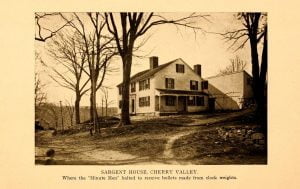
In all the Indian Wars from 1744 to 1763, especially the French and Indian, Leicester furnished a large number of men. Captain Brown, of this town, commanded a company at the capture of Louisburg. In 1756, fifteen men enlisted from Leicester in the expedition against Crown Point and twenty-three Leicester men were at the downfall of Quebec.
The town took an active and prominent part in the War of the American Revolution. Col. William Henshaw, who in 1771 superintended the building on Mt. Pleasant, now known as the Tarleton House, and where his brother, Joseph Henshaw, lived, was the organizer of the world famous “Minute Men.” From the letter of instructions which was sent to their representative at the General Court, and from later “resolutions,” we are made to believe that Leicester was the home of men of unusual intellectual ability. Many others had been well trained in the earlier wars and now rendered valuable service to their country. During one year, 1775, there were eighteen town meetings, so high did the fire of patriotism burn.
In May, 1770, a company of forty-six men was formed and was drilled, to be ready for war at a minute’s notice.
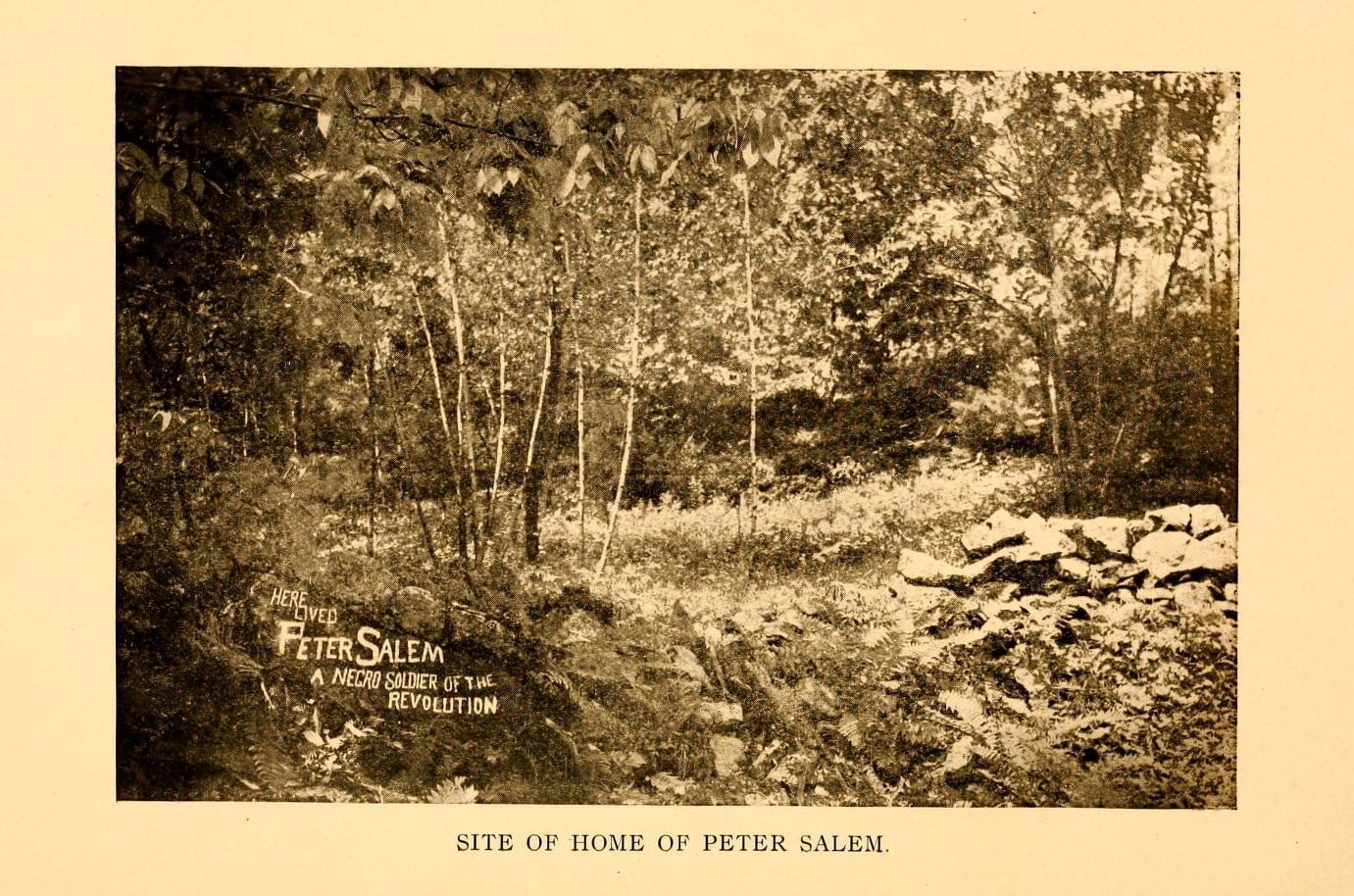
Late in the afternoon of the nineteenth of April, 1775, the alarm was given by a messenger, riding hard, and that same afternoon, under the leadership of Captain Seth Washburn, the blacksmith, the company of Leicester’s minute men were marching to battle. They halted at the house of Nathan Sargent in Cherry Valley (still standing near the top of the hill on Sargent Street), and obtained a supply of bullets which had been melted and molded from Mr. Sargent’s clock weights. They arrived in time to take part in the battle of Bunker Hill, though delayed by the traitor, Dr. Church. The negro, Peter Salem, who shot Major Pitcairn, was, for many years after the war, a familiar figure in Leicester. The site of his home, on Peter Salem Street, has been marked by the Daughters of the American Revolution. He was buried in Framingham.
Between 1775 and 1781 there were twenty-eight drafts for soldiers made upon this town. There were so few men left that the town records are exceedingly meagre. Two hundred and fifty-four recruits were furnished besides the seventy-two who marched at the first alarm, the “three years men,” and others supplied at various times to complete troops as required.
More than eight thousand dollars was paid by Leicester for war expenses, and a barrel of powder and twelve muskets furnished. Captain Washburn was for some time “muster-master” for Worcester County, and Leicester was a storehouse of supplies and ammunition.
Leicester men were engaged in many of the great battles of the Revolution, the stirring tale of Solomon Parsons at Monmouth being a sample of their patriotism.

Where a garrison is said to have been maintained in Colonial days.
During Burgoyne’s army’s march to Boston in 1777, as prisoners of war, after the surrender of Saratoga, an encampment was made in the grove where Grove Street, Leicester Center, is now located. Another party stopped for lunch on the Eddy Farm, in the northern part of the town. It is related that Gen. George Washington mentions in his diary having passed through Leicester on Friday, October twenty-third, 1789, General Lafayette also went through Leicester. A note of this event, which “all the town turned out to see,” is found in more than one diary and story. This occurred September third, 1824.
The Civil War again aroused the patriots of the town, and the first regiment to march from the state, the sixth Massachusetts, was under the command of Col. Edward F. Jones of Leicester. Lieutenant Joseph Waldo Denny, with the Worcester Light Infantry, was a Leicester boy, and in all, probably, two hundred and seventy-two Leicester men fought in the War of the Rebellion from 1861 to 1865. Memorial Hall, which occupies a part of the first floor of the Town House, the Town Hall occupying the entire upper floor, was set apart in memory of those who lost their lives for their country, in the War of the Rebellion. Marble tablets upon the wall are inscribed with the names, and other data, of those who fell. This hall now provides a meeting place for the veterans and kindred societies.
The Spanish War, 1895, called forth but two or three Leicester men, but a Relief Society was organized by the women and did splendid work supplying the needs of the soldiers at the front.
Miscellaneous Notes

The Leicester of today has a reputation as a select summer resort. Its population by the 1910 census was three thousand two hundred and thirty-seven.
When the route of the Western Railroad was mapped out, Leicester was on its line and a tunnel was contemplated to avoid the hill. This project was finally abandoned, though Leicester is on the line of the Boston & Albany railroad; the station is at Rochdale.
Upon a hill overlooking a part of the Center Village of Leicester is located a flourishing country club house and grounds, with golf links, tennis courts, boat house and so forth. The club was incorporated in 1910, but was the outgrowth of a local golf club of years’ standing.
Stonewall Farm, in the center of Leicester, and on Leicester Hill, the residence of Col. Samuel E. Winslow, is one of the finest estates in Worcester County. The main house was built in 1833.
If an attempt should he made to enumerate the famous men and women whose lives have been linked with the history of Leicester, the task would not only be formidable, but the result would forever be incomplete. It would be a list including eminent clergymen, statesmen, warriors, inventors, artists, actors, politicians, lawyers, physicians, scholars, philanthropists, and financiers. The very atmosphere of the place appears to foster intellectual acumen and business shrewdness, with an admixture of patriotism.
Bibliography on the History and Genealogy of Leicester, Massachusetts
For more extended accounts of Leicester the following references are recommended, besides the town records. All of these are freely available online!
- Vital records of Leicester, Massachusetts, to the end of the year 1849
- History of Leicester Massachusetts
- Coolidge, A. H. A brief history of Leicester, Massachusetts
Includes biographies and portraits of Dr. Edward Flint, Dea. Joshua Murdock, Joseph A. Denny, Dwight Bisco, Capt. Hiram Knight, Rev. Samuel May, Pliny Earle MD, Joshua Murdock Jr., Edward Sargent, Billings Mann, Alonzo White, and Salem Livermore, - Historical sketches of the town of Leicester, Massachusetts, during the first century from its settlement
Includes genealogies of Leicester Massachusetts from page 342-415. - Topographical and historical sketches of the town of Leicester, in the commonwealth of Massachusetts:
furnished for the Worcester magazine and historical journal - The Town of Leicester Massachusetts, by John White Chadwick.
Published in The New England magazine. New Series, Volume 22, Issue 3 (May 1900) - An address commemorative of the part taken by the inhabitants of the original town of Leicester
- Celebration of the one hundred and fiftieth anniversary of the organization of the town of Leicester, July 4, 1871
- Brief Sketch of the History of Leicester Academy
- The Greenville Baptist church in Leicester, Massachusetts
exercises on the 150th anniversary of its formation, September 28, 1888 - History of the Second Congregational church and society in Leicester, Massachusetts
- History of Spencer, Massachusetts, from its earliest settlement to the year 1860:
including a brief sketch of Leicester, to the year 1753 - Annual reports of the town officers of the town of Leicester, Massachusetts
- Coolidge, A. H. A brief history of Leicester, Massachusetts
- Genealogies of Leicester Massachusetts Families
- Historical sketches of the town of Leicester, Massachusetts, during the first century from its settlement
Includes genealogies of Leicester Massachusetts from page 342-415. - The family of Rush S. and Jane E. Brown, their ancestors and descendants
Parley Brown (d.1776) lived in Leicester, Worcester County, Massachusetts, and served in the Revolutionary War. Rush Spooner Brown (1846-1909), a grandson, was born in Oneida County, New York, moved to Portage, Wisconsin in 1870, where he married Jennie McDonald in 1871, and moved to Seattle, Washington in 1888. In 1893, he decided to become a farmer, which he did first in Bates County, Missouri and later in Clark County, Washington. Descendants and relatives lived in Wisconsin, Missouri, Washington, California and elsewhere. - William Brown, English immigrant of Hatfield and Leicester, Massachusetts and his descendants, c1669-1994
William Brown was born ca. 1669 in England and immigrated to Massachusetts before 1686. All his children were born in Hatfield, Massachusetts. He died in Leicester, Massachusetts in 1752. - Genealogy of the Denny family in England and America:
Descendants of John Denny of Combs, Suffolk, England in 1439 - Nathan Lamb of Leicester, Massachusetts: his ancestors and descendants
- John and Charlotte (Sargent) Pike of Leicester, Paxton, and Brookfield, Massachusetts
- Descendants of William and Sarah Thompson of Leicester, Mass.:
Six generations of Thompsons whose Scotch-Irish ancestors probably came to New England in 1718 - Family history of Leonard Wallace:
Ancestors and descendants 1731-1979; and allied lines Wallace, Wright, Carson, Steadman, Vennard. James Wallis (ca.1695-ca.1747) and his family lived at Leicester, Worcester Co., Massachusetts. He married Mary (d.1769) who died at Colrain, Mass. They were the parents of Agnes, James and John. Their son John (1736-1792) married Agnes Lindsey at Pelham, Mass. in 1761. They were the parents of four known children: John, William, David and Nancy. They were the ancestors of Leonard. Late in their lives their family moved to Franconia, New Hampshire. - The Warren family:
Descendants of Ebenezer H. Warren, Leicester, Massachusetts, 1714-1800, thru Matthew Raymond Warren, Oceanside, California, 1991-, with special emphasis on Thomas Spencer Warren, Anaheim, California, 1903- - Genealogy and history of the Watson family from Irish emigrants to Mayflower descendants
Matthew Watson married Mary Orr in County Derry, Ireland in 1695. They came to Massachusetts in 1718, settling in Leicester in 1720. This research identifies a large number of this couple’s descendants, with a view to connecting the California and Texas branches of the Watson family. - History and genealogy of the Watson family, descendants of Matthew Watson, who came to America in 1718
Matthew Watson (d.1720), of English lineage, married Mary Orr in 1695, and in 1718 the family immigrated from Ireland to Boston, Massachusetts and settled in Leicester, Massachusetts. Descendants and relatives lived in New England, New York, New Jersey, Pennsylvania, Ohio, Nebraska, Rhode Island, California, Nevada, Michigan and elsewhere. - Wheeler and Warren families
Descendants of George Wheeler, Concord, Mass., 1638, through Deacon Thomas Wheeler, Concord, 1696, and of John Warren, Boston, Mass., 1630, through Ebnezer Warren, Leicester, Mass., 1744 - Some descendants of William Wicker of Massachusetts
William Wicker (1695-1769) was in Leicester, Massachusetts in 1720. He had married Rebakah in 1718 in Dorchester, Massachusetts and later died in Leicester. Descendants lived in Massachusetts, Vermont, New York, Ohio, Wisconsin, Iowa, Texas, California, Illinois, and elsewhere.
- Historical sketches of the town of Leicester, Massachusetts, during the first century from its settlement
